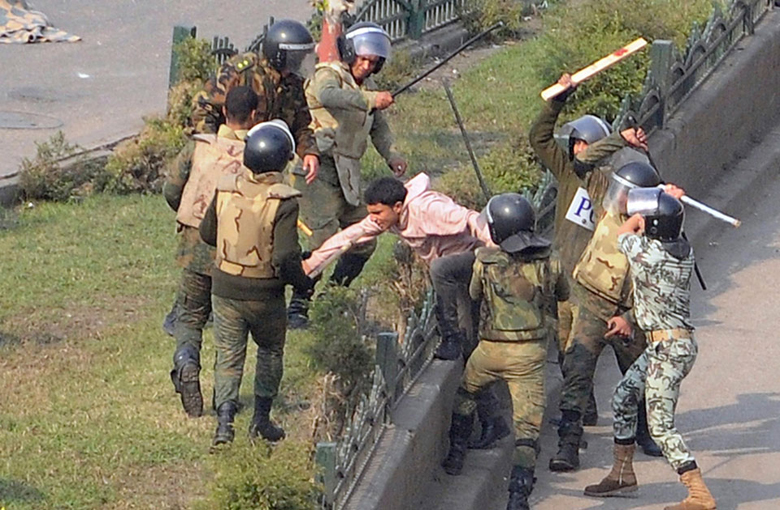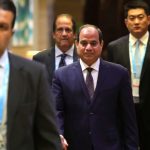by Joe Stork
Egypt’s Interior Ministry on April 11 posted on its official Facebook page a familiar statement: security forces “exchanged fire” with a “terrorist cell” in the north Sinai city of al-Arish, killing 11. The reported incident occurred a day or so after a 15-year-old suicide bomber killed four police officers and three civilians, including a six-year-old, in the small Sinai town of Sheikh Zuwayd on April 9, and a separate attack killed four policemen.
The same day, the Interior Ministry announced a “proactive” raid that left six of the “terrorist Brotherhood” dead in the Nile Delta governorate of Qalyubia. Neither of the ministry incident reports indicated that any “terrorists” had been wounded or captured or had escaped. Nor did they indicate if had there been any casualties among the officers. Neither report named any of those killed while both mentioned the confiscation of a relatively small number of guns and improvised explosive devices.
The purported circumstances of both incidents sounded awfully familiar. A week earlier, Reuters published a lengthy analysis of 108 incidents of clashes reported by Egyptian officials in the three-and-a-half years between July 2015 and the end of 2018. The incidents involved 471 men, of whom only six survived—a kill ratio of 98.7 percent, Reuters concluded. Five security officers were killed in the incidents and 37 injured. The Reuters report zeroed in on 11 of the men killed. Forensic experts who viewed photos of scenes thought it highly unlikely that the deaths occurred in exchanges of gunfire, as claimed by authorities. Noted pathologist Derrick Pounder examined the case of Zakaria Mahmoud, whom authorities claimed was an alleged “fugitive terrorist” killed in a shootout on July 15, 2017, and concluded “a more likely scenario is that the victim was kneeling with the shooter standing close on the right side.” Mahmoud’s cousin Souhail Ahmed was allegedly killed in the same “shootout,” but the different stages of decomposition indicated he had died 36 to 48 hours earlier.
According to the Reuters investigation, most of those killed were in their twenties. The Interior Ministry statements, which often followed attacks by armed Islamists, said that 320 of those killed were “terrorists” and 28 were “criminals or drug dealers.” The statements, some of which included purported crime scene photos, provided no names for 302 of the 465 killed. Instead of providing precise locations, which, in many cases Reuters said, “were in remote desert or mountain areas.” Pounder, the forensic pathologist, examined 20 of the photos and pointed to blood and drag marks in the sand indicating that the bodies had been moved after they were killed. Depressions in the sand “suggested two of the men were shot while in a kneeling position.”
The killing of 37-year-old Khaled Emam, documented in the Reuters report, illustrated another pattern. The Interior Ministry said on October 2, 2017 that its forces had killed him and two others in a shootout. But, according to his family, he had been “snatched from the street” months earlier, in June, by masked men. A relative who found Emam in the mortuary said that his body showed multiple signs of torture.
Khaled Emam’s killing resembled other incidents, not included in the Reuters report, where the “fugitives” killed had in fact been apprehended and “disappeared” weeks or months earlier and ended up dead after an alleged exchange of fire with security forces.
The Interior Ministry stated on January 13, 2017—four days after attacks on two police checkpoints in al-Arish left eight police dead—that security forces, after coming under fire from Islamic State fighters in an abandoned building in al-Arish, returned fire killing all 10 of those inside. In a heavily edited video that the ministry posted on Facebook the same day, several commandos approaching a building fire at a man on the ground outside, while six male bodies in civilian clothes lie in various rooms inside amidst weapons, pools of blood, and bullet-pocked walls.
Relatives of three of the men killed in the incident told Human Rights Watch that they had been arrested the previous October and November, months earlier, and showed receipts of telegrams they had sent at that time to authorities inquiring about their whereabouts. A lawyer and member of the quasi-official National Council for Human Rights said that six of those killed had been among several hundred persons named on a list he had earlier delivered to a presidential pardon committee. A lawyer representing one family said that ministry officials contacted the relatives to tell them to halt their efforts.
Military experts who reviewed the video at the request of Human Rights Watch expressed doubt about its authenticity, noting that the commandos did not behave as if they were under threat. A forensic expert observed that someone had moved at least one of the bodies prior to filming the video. Relatives of several of the victims said that they viewed their bodies at the morgue. The victims apparently had each been shot once in the head, and the bodies bore signs of electric shocks and cigarette burns. Relatives of two victims said former detainees had approached them after the men were arrested to say that they had seen them in the National Security Agency section of the Interior Ministry headquarters in al-Arish.
Egyptian authorities do not allow access to Sinai for independent observers and have prosecuted and jailed Egyptian journalists who have written about the conflict there.
In April 2017, Human Rights Watch published an investigation into a separate incident in northern Sinai in which military forces executed two and perhaps as many as eight unarmed persons already in custody. A video aired by a Turkey-based television channel showed a man in a camouflage uniform, separately identified as head of a local militia working closely with the Egyptian army, executing brothers Daoud Sabri al-Awabdah, 16, and Abd al-Hadi Sabri Abdullah, 19, with an assault rifle. The video shows a total of eight bodies on the ground as well as US-supplied Humvee vehicles in the vicinity. An Egyptian intelligence officer is seen observing the two executions. The al-Awabdah brothers had been arrested and “disappeared” in mid-July 2016.
The date of the execution video is not known, but a separate video posted on a pro-government Facebook page on November 20, 2016 shows what appear to be the same eight bodies, as well as a building like one in the execution video. The November video shows six soldiers standing next to the bodies. One says, “This is the revenge for those who died.” In another video from the same pro-government Facebook page, a male voice asks, “Should I change the position of the gun?” The person filming the video responds, “Finish, finish.” A photo accompanying a December 2016 government statement includes two of the bodies seen in the execution video. In that statement, an army spokesperson describes the operation as law enforcement forces “tighten[ing] their security grip in the areas of countering terrorist activities in North Sinai, where they managed to eliminate eight armed terrorist elements.”
Joe Stork is chair of the Gulf Centre for Human Rights advisory board and former deputy director of the Middle East division at Human Rights Watch.





